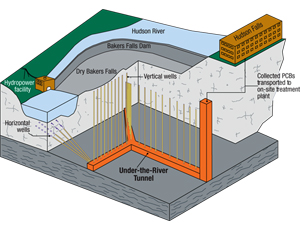Thirty-two years after the last polychlorinated biphenyls (PCBs) were discharged into the Hudson River from manufacturing complexes, General Electric Co. began dredging on May 15 to remove 400,000 tons of contaminated sediment along a six-mile stretch near Fort Edward, N.Y. Additional dredging is planned downriver along a 34-mile section to Troy for a 2015 completion.
Fairfield, Conn.-based GE has not released costs, but the U.S. Environmental Protection Agency estimates total cleanup at about $750 million. Additionally, New York State Dept of Environmental Conservation is montoring a tunnel-collection gallery drilled and blasted beneath the river to collect PCBs that leached into bedrock.
The dredging results from EPA’s February 2002 record of decision. PCBs were used as a high-temperature insulator in the manufacture of transformers and capacitors and were found to be a human carcinogen that bio-accumulates in fish.
“The PCBs tend to accumulate in the slow-moving portions of the river, like turns and bends,” says Kristen P. Skopeck, an EPA spokeswoman. “So the dredging is not normally bank to bank but rather in targeted spots.”
Twelve barge-mounted excavators are now using clamshell buckets guided by a global-positioning system to load sediment into hopper barges, which will be unloaded at a nearby 110-acre processing plant. The plant is fitted with a trommel to separate debris, two hydrocyclones to remove grit and sand and 12 filter presses for dewatering. Water will be processed to drinking-water standards and discharged into the river. Dried sediment will be shipped by rail to a hazardous-waste disposal facility at Andrews, Texas.
“This is a project of unprecedented scope and logistics,” says Mark Behan, GE spokesman. “The first phase is a full-scale test of whether the best dredging technologies can achieve rigorous EPA performance standards.”
Those standards require dredging contractor Cashman Marine, Quincy, Mass., to maintain a production standard of 5,000 cu yd per day. When complete, maximum PCB suspension levels are to be 500 parts per trillion and residual levels .25 parts per million. Dredging depths range from 3 in. to 9 ft.
Dredging is not the only action. At Hudson Falls, N.Y., a joint venture of Merco Inc., Lebanon, N.J., and Obayashi Corp., San Francisco, recently finished the tunnel and drain complex. A series of 4-in.-dia drains channel PCBs to two Y-shaped 1,000-ft long, 10-ft-dia tunnels 200 ft deep in bedrock. PCBs will be pumped via a temporary lift station to a 375-gallon-per-minute wastewater treatment plant. Water will be discharged into the river; oil will be sent to a licensed facility at Port Arthur, Texas. Work started in late 2007 with the drilling of the 24-ft-dia shaft.
The complex was designed by Brierley Associates LLC, Littleton, Colo., and GeoTrans Inc., Sterling, Va. The shaft is lined with shotcrete but the tunnels and drains are open rock. Final electrical, mechanical and instrumentation fit-out will be started in 2010. “The tunnel is part of a remediation plan that has reduced PCB flow to bedrock to less than three ounces per day,” says Behan. “The tunnels will capture and process that.”
“Initial indications are that the tunnel-drain collection system is performing as designed,” says a DEC spokesman. “Further hydraulic monitoring is required, however.”
From 1947 to 1977 GE discharged about 1.3 million lb of PCBs into the river from plants at Fort Edward and Hudson Falls. Fort Edward is still producing capacitors, but without PCBs. Hudson Falls ceased production in the 1980s. Some 20,300 kilograms of PCBs will be removed in the first phase, to be completed in October. EPA estimates a total of 1.8 million cu yd of sediment and 113,000 kg of PCBs will be removed.



Post a comment to this article
Report Abusive Comment